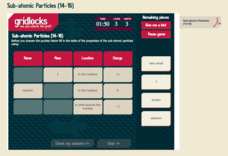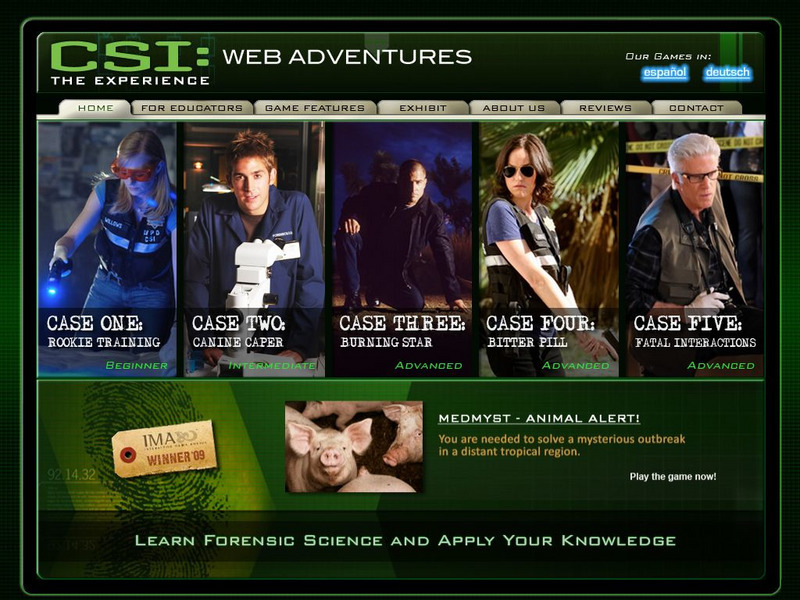Royal Society of Chemistry
Forensic Tests
Flame tests determine if there is a specific metal in a chemical compound. Young forensic scientists review their understanding of flame tests and hydroxide precipitates by solving puzzles. The timed review encourages mastery.
Royal Society of Chemistry
Units of Volume
Did you know in the UK a quart is smaller than in America? This explains why a standard unit of measure is necessary for volume. Young scientists learn the similarities and differences between five different units used to measure volume....
Royal Society of Chemistry
Moles Equations (14-16)
In chemistry, the mole is a unit of measurement, much like a millimeter or liter. After learning about moles, scholars learn various equations relating to mass, volume, and concentration. They review each of these equations in a few...
Royal Society of Chemistry
Flame Test Colours
Scientists identify elements by the color of flame they produce because each element is defined by exactly one line on the emission spectrum. By completing a series of puzzles, scholars reinforce their knowledge of the results of flame...
Royal Society of Chemistry
Sub-Atomic Particles (14-16)
In 1897, J.J. Thomson discovered the electron, the first subatomic particle proven to exist. Scholars review their understanding of electrons, protons, and neutrons as they work through the puzzles. Each puzzle connects two or three...
Royal Society of Chemistry
State Symbols
When water is a solvent in a chemical equation, we consider it an aqueous solution. Scholars match the name of four states of matter to their proper symbol in a chemical equation. Four puzzles provide repetition to help pupils remember...
Royal Society of Chemistry
Types of Bonding
A covalent bond yells at an ionic bond, "Didn't anyone teach you to share?" Four matching puzzles allow pupils to review covalent, ionic, and metallic bonding. They apply logic and problem solving to complete gridlocks including the...
Royal Society of Chemistry
The Blast Furnace
The largest chemical reactors are blast furnaces, used to make iron from ore. Scholars explore reactants by first matching each one to its purpose and formula. Then, a series of three gridlock puzzles reinforce the content while...
Curated OER
Crime Scenes
In this crime scene worksheet, students answer multiple choice questions on different situations involving crime scenes. Students complete 5 questions.
Curated OER
Dig Magazine Archeology Quiz #81
In this Dig Magazine archeology quiz, learners answer 4 multiple choice questions complementing the February 2007 issue. Page contains answer and additional resources link.
Curated OER
Dig Magazine Archeology Quiz #60
In this Dig Magazine archeology quiz, learners answer 4 multiple choice questions covering a variety of topics. Page contains answer and additional resources link.
Curated OER
Dig Magazine Archeology Quiz #106
In this Dig Magazine archeology quiz, students answer 12 multiple choice questions complementing the October 2009 issue. Page contains answer and additional resources link.
University of Utah
University of Utah: Genetic Science Learning Center: Dna and Verdicts
Part of a site on genetics, this page explores DNA as a forensic science. Explains how and why DNA can be used to convict or acquit a criminal from wrongdoing using forensic DNA analysis. Teacher resources too.
Other
Tech Museum of Innovation: Forensics
This is part of the overview page for the online exhibit on Genetics from the Tech Museum of Innovation. This particular section focuses on forensic science and its work with modern crime detection.
Rice University
Rice University: Web Adventures: Csi: The Experience
Based on the CSI television show, this series of four role-playing games helps students learn the scientific method and try their hand at solving crimes. Discover if you have what it takes to be a forensic scientist.
Rice University
Rice University: N Squad: Alcohol and Body Systems
Three problem-solving detective games involve players in investigations of the effect of alcohol on the body's digestive, circulatory, and nervous systems.
Other popular searches
- Forensic Science Powerpoint
- Forensic Science Project
- Forensic Science Blood Type
- Vocabulary Forensic Science
- Forensic Science Lab
- Forensic Science Power Point
- Forensic Science Activities
- Forensic Science Fingerprint
- History of Forensic Science
- Forensic Science Entomology
- Forensic Science Archaeology
- Forensic Science Archeology















